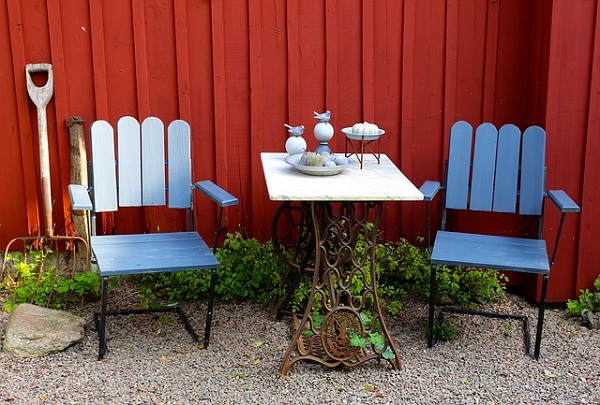
0800 377 7507
Get in touchTops tips for cleaning garden furniture
With brighter, sunnier days and with bank holidays around the corner, you’ll no doubt be thinking of spending some time outside and dusting down the BBQ (check back on Friday’s blog for some handy tips on cleaning BBQs) and garden furniture. To make Spring Cleaning your garden furniture easier, MOLLY MAID, the professional domestic cleaning experts have put together some top tips for cleaning garden furniture from dealing with wood and metal to plastic garden tables and chairs.
Wood
Wooden garden furniture can be so elegant and fitting to its natural surroundings, but it does require upkeep and some tender loving care in the form of cleaning to keep it looking its best. Most furniture made of wood can be cleaned by using the following top tips, with the exception of teak.
- Clean wooden garden furniture using a warm solution of sugar soap and a scrubbing brush. For more stubborn areas, you can leave the solution on the furniture for a few minutes before shifting them with the scrubbing brush.
- Then using your hose pipe (not pressure washer) rinse off and leave to dry.
- If mildew is visible on your garden furniture, a top tip to cleaning your wooden garden furniture is to make a safe and effective solution made up by mixing 1 cup of any household bleach, 1 cup of washing powder and 1/2 bucket of warm water. Soak your furniture with the bleach solution and let it soak for 5 minutes (no longer). Then, simply hose off the solution and the mould, mildew or moss problem should disappear. Please take the necessary precautions when handling bleach solutions.
- Try to avoid putting any oil or sealants on new oak furniture as oils tend to make the wood go black and pick up dirt, while other finishes just sit on the surface, change the texture of the wood and need frequent maintenance. The only exception to this rule is if the wood has been exposed to the elements for more than 10 years on average, the surface grain will have opened up and will need replenishing with oils.
Teak
By contrary, teak, is a popular alternative to some hard and soft wood furniture due to its resistance to the outdoor elements. Teak tends not to require protective treatments that other wooden furniture may in the form of varnishes and oiling as teak is naturally resistant to the outdoor extremes. However, there is no getting away from dust and dirt, so it still requires some care!
- To remove dirt and dust, hose it off with plain water – that is all that is required.
- To remove stubborn dirt or bird droppings for example, use warm soapy water and a non-abrasive cloth or soft sponge.
- Frequency of cleaning depends on the amount of dirt your teak garden furniture is exposed to, but washing it once a week or every two weeks is usually enough to keep it clean and look inviting.
- Please be aware that it is generally not a good idea to use teak oil if your garden furniture is made from grade A teak, because it destroys its natural protective oils. Once you start oiling teak garden furniture you must continue if you want it to remain suitable for outdoor use as most teak oils are made with solvents which replace natural teak oils that maintain the wood’s resistance.
Metal
Oxidation, or rusting, tends to be the most common problem with aluminium or metal furniture. Try some of the below top tips for cleaning metal garden furniture:
- Prior to cleaning, prepare the area by removing as much of the imperfection as possible using a metal polishing paste or a 1:1 solution of white vinegar and water.
- Avoid chemicals such as ammonia and trisodium phosphate (TSP); alkaline cleaners can cause oxidation.
- Hose down and wash aluminium frequently to preserve its natural lustre.
- To remove any scratch marks, use a soft cloth dampened with a nonabrasive product.
- To prevent rust, sand the rusted paint and metal down, wipe off the residue with a cloth dampened with mineral spirit. Then, use a rust-resistant primer before painting with rust-resistant paint.
- In more dramatic cases, you could consider having your wrought-iron furniture sandblasted or powder-coated for added protection.
- A way to protect the metal material after cleaning with water, is to apply a coat or two of car wax.
Plastic
Nobody likes the look of unsightly, dirty plastic garden furniture which has lost its inviting appeal, particularly if it was once sparkling white! To help restore the colour and its’ shine, try the following top tips for cleaning garden furniture:
- Mix 50ml of vinegar with 1L of warm water and wipe down furniture and hose off.
- For more stubborn stains, sprinkle some bicarbonate of soda onto a sponge and gently wipe off the stains.
- Once the furniture is dry, apply some WD-40 and polish to restore the shine. Make sure you wipe down your plastic furniture well to save yourself from staining clothing.
- Then polish with car wax to form a protective layer.
We hope that the above top tips for cleaning garden furniture will help to encourage you to start enjoying the outdoors now that Spring has arrived.
